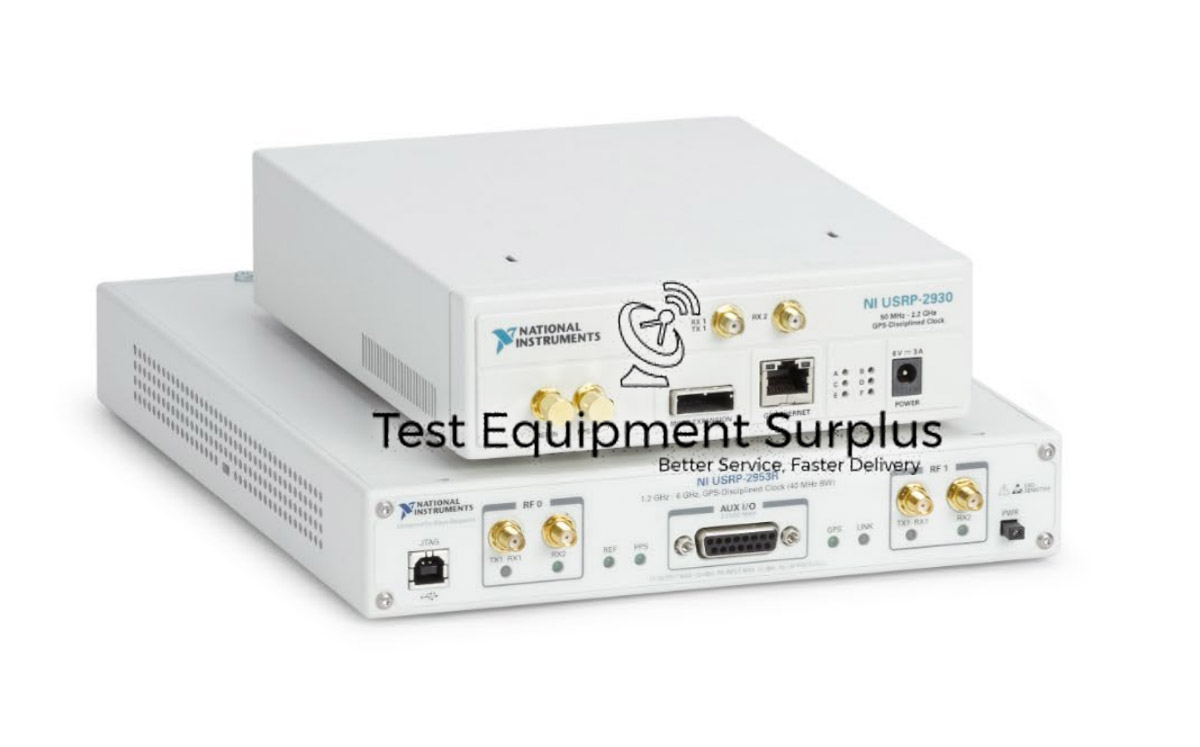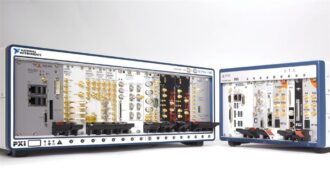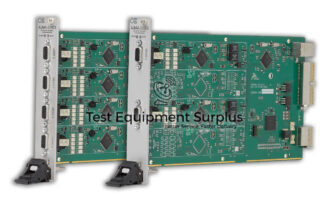Description
The National Instruments USRP-2974, with Part Number 785606-01, is powered by an Intel i7 processor and features a Kintex-7 XC7K410T FPGA with 1 GB DRAM, providing robust processing capabilities required for complex software-defined radio applications. It supports various operating systems, including Linux Fedora and NI Linux RT, offering flexibility in development environments.
This device operates across a wide frequency range from 10 MHz to 6 GHz and includes 2 transmitter channels and 2 receiver channels, with the latter capable of handling up to 160 MHz of instantaneous real-time bandwidth. The frequency can be finely tuned with a step size of less than 1 kHz, allowing for precise control over signal generation and analysis.
Equipped with a GPS-disciplined oscillator (GPSDO), the USRP-2974 achieves up to 5 ppb frequency accuracy when locked to GPS signals, ensuring high precision in timing and synchronization tasks. The device’s power requirements are moderate with an input voltage range of 14.25 V to 15.75 V DC and a maximum power consumption of 10 A and 150 watts.
For networking, the USRP-2974 features a high-speed 1 SFP+ 10G Ethernet port and a conventional 1 RJ45 type 1G Ethernet port, facilitating fast and efficient data transfer. Furthermore, it is equipped with 8 gigabytes of RAM, which ensures smooth and lag-free performance during operation.
| Specification | Detail |
|---|---|
| Part Number | 785606-01 |
| Processor | Intel i7 |
| FPGA | Kintex-7 XC7K410T with 1 GB DRAM |
| Operating Systems Supported | Linux Fedora, NI Linux RT, etc. |
| Frequency Range | 10 MHz to 6 GHz |
| Transmitter Channels | 2 |
| Receiver Channels | 2 with up to 160 MHz of instantaneous real-time bandwidth |
| Frequency Step | < 1 kHz |
| GPS-disciplined Oscillator (GPSDO) | Yes, with up to 5 ppb frequency accuracy when locked to GPS |
| Input Voltage Range | 14.25 V to 15.75 V DC |
| Power Consumption | 10 A and 150 watts maximum |
| Network Communication | 1 SFP+ 10G Ethernet port, 1 RJ45 type 1G Ethernet port |
| RAM | 8 gigabytes |
Question 1: What are the processor specifications and the FPGA type used in the National Instruments USRP-2974, and what frequency range and bandwidth capabilities does it support?
Answer 1: The National Instruments USRP-2974 operates across a frequency range of 10 MHz to 6 GHz and is capable of handling up to 160 MHz of instantaneous real-time bandwidth.
Question 2: What type of applications can the National Instruments USRP-2974, with its Intel i7 processor and Kintex-7 XC7K410T FPGA, accommodate due to its powerful processing capabilities and wide frequency range from 10 MHz to 6 GHz?
Answer 2: The National Instruments USRP-2974 is equipped with an Intel i7 processor, a Kintex-7 XC7K410T FPGA, and 1 GB of DRAM, supports Linux Fedora and NI Linux RT operating systems, operates within a 10 MHz to 6 GHz frequency range, and offers 2 transmitter and 2 receiver channels with up to 160 MHz of real-time bandwidth, fine frequency tuning with less than 1 kHz step size, and high precision GPS-discipl
Question 3: What operating systems are supported by the National Instruments USRP-2974, which is equipped with a Kintex-7 XC7K410T FPGA and an Intel i7 processor?
Answer 3: The National Instruments USRP-2974 supports Linux Fedora and NI Linux RT operating systems.
Question 4: What are the key features and specifications of the National Instruments USRP-2974, including its processor type, FPGA, supported operating systems, frequency range, channel specifications, and networking capabilities?
Answer 4: The National Instruments USRP-2974 is well-suited for complex software-defined radio applications, including high-frequency trading, signal intelligence, wireless prototyping, and communications research, due to its powerful Intel i7 processor, Kintex-7 XC7K410T FPGA, and wide frequency range from 10 MHz to 6 GHz.
Question 5: What is the range of operating frequency for the National Instruments USRP-2974, and what is its maximum instantaneous real-time bandwidth capability?
Answer 5: The National Instruments USRP-2974 is powered by an Intel i7 processor and utilizes a Kintex-7 XC7K410T FPGA, supporting a wide frequency range from 10 MHz to 6 GHz and offering 2 receiver channels capable of managing up to 160 MHz of instantaneous real-time bandwidth.




